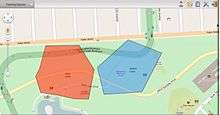Geo-fence

A geo-fence is a virtual perimeter for a real-world geographic area.[1] A geo-fence could be dynamically generated—as in a radius around a point location, or a geo-fence can be a predefined set of boundaries (such as school zones or neighborhood boundaries).
The use of a geo-fence is called geo-fencing, and one example of usage involves a location-aware device of a location-based service (LBS) user entering or exiting a geo-fence. This activity could trigger an alert to the device's user as well as messaging to the geo-fence operator. This info, which could contain the location of the device, could be sent to a mobile telephone or an email account.
Applications
Geofencing, used with child location services, can notify parents if a child leaves a designated area.[2]
Geofencing used with locationized firearms can restrict those firearms to fire only in locations where their firing is permitted, thereby making them unable to be used elsewhere.
Geofencing is critical to telematics. It allows users of the system to draw zones around places of work, customer's sites and secure areas. These geo-fences when crossed by an equipped vehicle or person can trigger a warning to the user or operator via SMS or email.
In some companies, geofencing is used by the human resource department to monitor employees working in special locations especially those doing field works. Using a geofencing tool, an employee is allowed to log his or her attendance using a GPS-enabled device when within a designated perimeter.
Other applications include sending an alert if a vehicle is stolen[3] and notifying rangers when wildlife stray into farmland.[4]
Geo-fence can be used for location based messaging for tourist safety and communication.[5]
Geofencing, in a security strategy model, provides security to wireless local area networks. This is done by using predefined borders (e.g., an office space with borders established by positioning technology attached to a specially programmed server). The office space becomes an authorized location for designated users and wireless mobile devices.[6]
One expert in global positioning system security, and a politician, has suggested that government regulators should encourage drone manufacturers to build geofencing constraints into unmanned aerial vehicle navigation systems that would override the commands of the unsophisticated operator, preventing the device from flying into protected airspace.[7][8]
See also
References
- ↑ "What is geo-fencing (geofencing)? - Definition from WhatIs.com". WhatIs.com. Retrieved 2016-12-10.
- ↑ De Lara, Eyal; Anthony LaMarca; Mahadev Satyanarayanan (2008). Location Systems: An Introduction to the Technology Behind Location Awareness. Morgan & Claypool Publishers. p. 88. ISBN 978-1-59829-581-8.
- ↑ "Motorcycle Tracker Updates Every 15 Seconds". Motorcycle USA. 23 January 2009. Retrieved 2009-01-26.
- ↑ "Kenya's elephants send text messages to rangers". CBS News. 11 February 2009.
- ↑ "Location Based Messaging for Tourist Safety and Communication" (PDF). UgoRound.com. 3 July 2017. Retrieved 21 September 2017.
- ↑ Hamid Jahankhani, A G Hessami, Feng Hsu: Global security, safety, and sustainability : 5th international conference, ICGS3 2009, London, UK, September 1-2, 2009 : proceedings. ISBN 978-3-642-04061-0
- ↑ "Todd Humphreys: Don't Overregulate Drones". Alcalde. 18 March 2015. Retrieved 2015-04-05.
- ↑ Schumer, Charles (19 August 2015). "Schumer proposes law". Retrieved 15 December 2015.
Further reading
- De Lara, Eyal; Anthony LaMarca, Mahadev Satyanarayanan (2008). Location Systems: An Introduction to the Technology Behind Location Awareness. Morgan & Claypool Publishers. p. 88. ISBN 978-1-59829-581-8.
- Anthony C. Ijeh, Allan J. Brimicombe, David S. Preston, Chris O. Imafidon (2009) "Geofencing in a Security Strategy Model." In Global Safety and Sustainability: 5th International Conference Proceedings. Jahankhani, H.; Hessami, A.G.; Hsu, F. (Eds.) p.104-111 © Springer-Verlag Berlin Heidelberg 2009. ISBN 978-3-642-04061-0